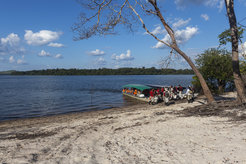Diversity Characterised Diets in the Late Holocene Amazon Basin
Although once considered a ‘counterfeit paradise,’ the Amazon Basin is a region of increasing interest in discussions of pre-colonial tropical land-use and social complexity, with evidence for plant domestication, soil modification, and even the formation of ‘Garden Cities’ along the Amazon River and its tributaries.
While these economic and social processes have, in the past, been linked to the arrival of carbohydrate rich crops, a new multidisciplinary study published in PLOS ONE, led by a collaboration between the Max Planck Institute for Geoanthropology, Scientia Consultoria Científica, and Universidade Federal do Pará in Brazil highlights the importance of the use of diverse wild plants and animals, indigenous domesticates, and river resources in different parts of the Amazon Basin.

Archaeobotanical research now demonstrates that the Amazon rainforest was an important centre for the domestication of crops, including cassava (Manihot esculenta ssp.), pineapple (Ananas comosus), rice (Oryza sp) and peach palm (Bactris gasipaes), opposing the argument that poor soils, high humidity and hydrological activity uniformly prevented the development of crops that could sustain large, sedentary, and complex societies in this part of the Neotropics.
Maize, a C4 plant and an important item currently cultivated around the world, was domesticated in Mexico over 8,000 years ago and has been found in sediments from archaeological sites in different parts of South America from 6,000 years ago. Recent genetic studies suggest further domestication processes may have occurred in this latter region. While maize has often been linked to the emergence of social complexity in the Americas, including within the Amazon Basin, its real importance to the diet of human societies in the region is still largely unknown.

In the new study, researchers apply stable isotope analysis to human and animal bone collagen and tooth enamel bioapatite recovered from archaeological sites in the Volta Grande do Rio Xingu. The Xingu River is an important Amazon tributary and, since the early 2000s, has been recognised as hosting Indigenous ‘Garden Cities’ prior to European arrival. Diversity in material culture and burial practices suggest that the region may have been an important site of population interaction, though little is known directly about the dietary practices of people in the area in the past.

The results obtained by the researchers provides some of the largest ‘baselines’ of isotope data from animals from archaeological contexts yet available for the Amazon. Comparison with the human samples demonstrates that, while present in human diets, maize did not play a major role in the subsistence strategies of these individuals. Instead, the data supports varied reliance on local crops such as manioc/cassava, wild plants and animals from forest settings, and a diversity of fish from the river.
Comparison of the novel data from the Xingu River with other published datasets in different parts of the Amazon Basin highlights there was no single adaptive pattern for pre-colonial populations in the Amazon, however. Indeed, settlement along different types of water courses, varying forest types, and social and economic contexts shaped the varying dietary focus on incoming maize and different parts of the aquatic and terrestrial tropical landscapes. The dynamic combination of hunting, fishing, vegetable harvesting and horticulture, adapted to local situations, seems to have provided an important avenue for regular food supplies and rich diets.


